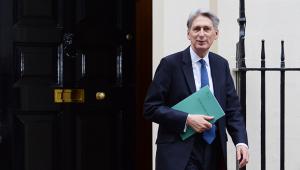Growth expectations for 2017 have been revised up from 1.4% to 2%, although growth is then expected to dip back down to 1.6% next year, rising to 1.7% in 2019 and 1.9% in 2020, he told the Commons in his Budget statement.
Borrowing forecasts were also down on those included in November’s Autumn Statement, with borrowing expected to come in at £51.7bn – £16.4bn below the Autumn Statement prediction.
“Overall public sector net borrowing as a percentage of GDP is predicted to fall from 3.8% last year to 2.6% this year,” Hammond told MPs.
However, the OBR’s Economic and fiscal outlook noted that the improved picture was largely down to one-off factors and timing effects that “flatter” this year’s figures at the expense of next year’s.
In particular, the OBR highlighted changes in timing to corporation tax return and EU contributions as well as evidence of greater income shifting to beat the April 2016 rise in dividend taxation.
According to OBR forecasts, borrowing is set to be 2.9% in 2017-18 and then to fall over the remainder of the Parliament, to 1.9% in 2018-19, 1% in 2019-20 reaching 0.7% in 2021-22 – its lowest level in two decades, Hammond said.
“The OBR expects cyclically adjusted public sector net borrowing to be 0.9% in 2020-2021, giving us £26bn of headroom against the headline 2% target in our new fiscal rules, maintaining our fiscal resilience over the period,” he added.
“The OBR’s forecast of lower near-term borrowing, coupled with recent strength in the economy, means lower debt across the period.”
Public debt is set to rise to 86.6% of GDP this year, before peaking at 88.8% next year, 1.4 percentage points below the Autumn Statement forecast.
“It then falls in 2018-19, for the first time since 2001-02 to 88.5%, it then continues to decline to 86.9% in 2019-20, 83%, in 2020-21 and then reaches 79.8% in 2021-22,” the chancellor added.
But he argued that, with debt of almost £1.7 trillion – equivalent to £62,000 for every household in the country – there would be no unfunded public spending. “The only responsible course of action…is to continue with our plan, undeterred by any short-term fluctuations,” Hammond said.
“We will not saddle our children with ever-increasing debts.”
Paul Johnson, director of the Institute for Fiscal Studies commented that today’s forecasts represented the biggest change in forecast between November and March in the OBR’s history, but warned that the improvement would not last.
Easily biggest change in OBR's history to current year's public finance forecasts between Nov and March. But improvement doesn't last
— Paul Johnson (@PJTheEconomist) March 8, 2017
CIPFA chief executive Rob Whiteman said the statement built on the previous Autumn Statement and was delivered by a confident chancellor. “The driving overall context remains that total national debt is too high and productivity too low. Today the Chancellor has launched a number of short and longer term initiatives that aim at tackling this, alongside some key support to deal with pressing problems that are happening now; not least social care,” he said.
Daniel Mahoney, head of economic research at the free market Centre for Policy Studies said: “It is welcome that, despite the UK’s borrowing forecasts improving, the Budget 2017 was not full of giveaways.”



















